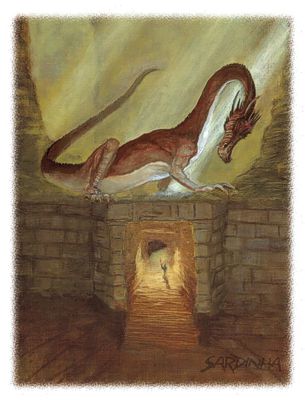

The Ruins of Undermountain • Monstrous Compendium Annual, Volume Three

| Climate/Terrain: | Any land or subterranean |
|---|---|
| Frequency: | Very rare |
| Organization: | Family/Pack (10% solitary) |
| Activity Cycle: | Any |
| Diet: | Carnivore |
| Intelligence: | Semi-(4) |
| Treasure: | Nil (except temple treasures, as guardian) |
| Alignment: | Lawful neutral |
| No. Appearing: | 1-8 |
| Armor Class: | 3 |
| Movement: | 9 |
| Hit Dice: | 10 |
| THAC0: | 11 |
| No. of Attacks: | 5 |
| Damage/Attack: | 1-8 (×4 claws)/2-16 (bite) |
| Special Attacks: | Fire breath |
| Special Defenses: | Nil |
| Magic Resistance: | 40% |
| Size: | G (40’+ long) |
| Morale: | Special |
| XP Value: | 5,000 |
Ibrandlin, or .lurkers in darkness,. as they are formally called, are creatures created from fire lizards by human clerics of the god Ibrandul (see Ecology below). They appear as fire lizards with long, thick tails; in other words, they look like elongated, wingless red dragons. Ibrandlin have gray scaled bodies, with red-and brown-mottled backs and reddish undersides. Hatchlings are light gray all over, their scales darkening with age.
Combat: Ibrandlin attack with a lethal combination of raking claws and a vicious bite. Their serpentine bodies rear up on their tails to enable them to use all four claws, and they can simultaneously claw and breathe fire. Their fire breath is usable every fifth round, and appears as a cone 5’ wide at the mouth, 10’ wide at the end, and 15’ long. The breath does 2-12 flame damage to all creatures it touches, half damage if a target’s save against breath weapon succeeds. An ibrandlin uses its bite attack for that round while breathing fire. If a being not immune to fire is right in front of the lurker’s maw when it breathes, that being suffers full flame damage.12 hit points, no save allowed, if a bite attack roll is successful. Lurkers are naturally immune to fire-based attacks.
Ibrandlin can climb, albeit slowly (MV 5), can pry open doors, and carry prey or objects. They lack the intelligence or precise control to wield magic items, but can duplicate an action they have just seen performed such as hurling a javelin of lightning or throwing a missile from a necklace of missiles. Consider any throwing motion an attack roll at a -3 penalty. If the attact misses, roll an additional 1d10 for deciding how far in feet the impact location is from its intended target.
Ibrandlin can pin creatures with a successful THAC0 roll. This replaces 3 claw attacks during the round, and means that a lurker has rolled its massive bulk atop a creature, though it uses its legs to displace most of its weight. Pinned creatures who lie quietly – verbal-only spellcasting possible – will be unharmed. Creatures who move or fight will find the ibrandlin’s full weight on them and effectively take crushing damage of 1-4 points each round. The trapped creatures can move slightly but incur a penalty of -3 on attacks and damage. A single lurker can pin and entrap up to five M-sized creatures.
To escape a lurker’s pin, a successful Strength Check and a successful Dexterity Check in the same round are both required, even if the lurker is dead; the Strength check allows the character to lift the ibrandlin’s bulk away, and the Dexterity check grants the chance to roll free out from under the monster. A held or paralyzed lurker’s flesh hardens: add a +10 penalty to the ability check rolls of a would-be escapee.
Habitat/Society: The god Ibrandul imparted secret breeding processes and transformation spells to his most faithful followers over the centuries, enabling them to create loyal temple guardians from captured fire lizards. Priests of Ibrandul are very excited: after hundreds of years, their artificially-created lurkers in darkness
are beginning to breed true, producing other ibrandlin rather than hatchling fire lizards!
These creatures are trained from birth to revere and protect men and women wearing the vestments of Ibrandul – dark purple robes or tunics with four interlocked silver circles – and to guard a lair, usually a temple, against intruders.
Always found as guardians, lurkers are found wherever priests of Ibrandul place them. The lizards prefer subterranean lairs or dark interiors of buildings, and usually sleep 50% of the time. They can tolerate wide extremes of temperature, and they also react instantly to any situations when awakened. Hatchlings are always taken from the birthing area by priests for training.
Lurkers do not hoard treasure. They form family groups with all inhabitants of a temple, working as a team to guard the common items and splendors of their home lair. If it remains on the same plane, a lurker removed from the lair will always know the direction to its home lair and will slowly, doggedly travel back. Lurkers who lose their masters will aggressively defend their lair, even if it is in ruins. If new individuals arrive clad in the familiar vestments of Ibrandul, such lost lurkers will readily accept new masters. Lurkers are trained to understand both one word verbal commands and gestures: Attack!
, Defend!
, Eat
, Don’t Eat
, and Stand Guard
(i.e. don.t let this creature move) are by far the most common.
Ecology: Ibrandlin ordinarily eat cows, lame horses, and other livestock that priests procure, and seem immune to diseases, poisons, rot grubs, and other parasites. They can be fed meat that would otherwise be buried or burned. They have no real enemies, although wyverns and dragons have been known to attack them. Their eggs are worth 5,500 gp, hatchlings 8,000 gp.both purchases carry the enmity of all priests of Ibrandul, who will try to seize them by all possible means.
